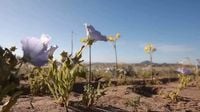In a spectacle rarely witnessed even by seasoned desert dwellers, Chile’s Atacama Desert—the world’s driest nonpolar desert—has erupted into a breathtaking display of wildflowers, dazzling locals and tourists alike with a vibrant carpet of color. This fleeting phenomenon, which unfolded in early October 2025, has transformed the arid landscape of Llanos de Challe National Park and surrounding regions into a living mosaic of pink, purple, yellow, red, blue, and white blooms. For a desert that typically receives a mere 2 millimeters (0.08 inches) of rainfall each year, such abundance is nothing short of extraordinary.
According to the Associated Press, the Atacama’s transformation follows a period of unusual downpours during the Southern Hemisphere’s winter months. Some high-elevation borderlands received as much as 60 millimeters (2.3 inches) of rain in July and August 2025—making this year one of the wettest in recent memory for the region. These rare rains provided the crucial trigger for more than 200 species of flower seeds, which lie dormant in the desert’s red and rocky soil, to burst into life. As Víctor Ardiles, chief curator of botany at Chile’s National Museum of Natural History, explained, “When certain moisture thresholds are met, (the seeds) activate, grow and then bloom.”
Yet, even with the rains, nature’s show is not guaranteed. Ardiles elaborated, “There are four key factors that determine whether this process reaches the seed—water, temperature, daylight and humidity. Not all the seeds will germinate, some will remain waiting … a portion will make it to the next generation, while others will be left behind along life’s path.” The result, this year, is a riot of color that has drawn visitors from far and wide—some traveling from as far as Santiago, 800 kilometers (497 miles) south of the Copiapó region, to witness the Atacama’s transformation firsthand.
For many, the journey is well worth it. “It’s one of those rare things you have to take advantage of,” said Maritza Barrera, who drove nearly six hours with her children to see the bloom in Llanos de Challe National Park. “It's more stunning than I could have imagined.”
The main threads in the floral carpet are shades of pink and purple, but streaks of yellow, red, blue, and white flowers weave through the landscape as well. The dominant flower, Cistanthe longiscapa—known locally as “pata de guanaco”—is at the heart of the spectacle. This hardy species, with its fuchsia-colored petals, has not only captured the attention of tourists but also of scientists who see it as a key to understanding survival in extreme environments.
Researchers at Chile’s Andres Bello University are now conducting genetic sequencing experiments on Cistanthe longiscapa to uncover the secrets that allow it to flourish under such harsh conditions. Ariel Orellana, director of the university’s Plant Biotechnology Center, described the stakes: “With climate change, droughts are becoming a serious problem for agriculture, for the world and our country. We need plants that are capable of tolerating that drought.”
Chile is no stranger to water challenges. The World Resources Institute ranks the country among the most water-stressed in the world, and studies warn of extreme drought conditions by 2050 across Chile’s fertile central valley—a region crucial for agricultural exports including wine, fruit, and livestock. The hope is that by studying the genetic and physiological traits of “pata de guanaco,” scientists can transfer its drought-tolerant characteristics to other crops, potentially offering a lifeline to farmers facing a drier future.
What makes Cistanthe longiscapa particularly intriguing, Orellana explained, is its ability to switch between different types of photosynthesis. Under stress from drought, intense sunlight, or salinity, the plant activates a water-saving method known as CAM (Crassulacean Acid Metabolism) photosynthesis, which allows it to conserve water by opening its stomata at night. When conditions improve, it reverts to the more common C3 photosynthesis, maximizing growth. “This flexibility makes it a great model for studying how genes control these changes,” Orellana said.
Cesar Pizarro Gacitua, head of biodiversity conservation at the Atacama region’s CONAF forestry agency, echoed the need for further research: “How does it produce enough food, perform photosynthesis, to survive extreme conditions?” The answers, scientists hope, could help crops around the world adapt as climate change intensifies.
While the desert’s current display is a feast for the senses, it is also a poignant reminder of the delicate balance that sustains such rare events. Most of the flowers will vanish by November, as the Southern Hemisphere’s summer sets in, though some drought-resistant species may linger until January 2026. The ephemeral nature of the bloom has prompted conservation efforts at the highest levels. In 2023, Chilean President Gabriel Boric established Desert Bloom National Park, converting about 220 square miles (570 square kilometers) of flower fields along the Pan-American Highway into a protected area. The move aims to safeguard these unique ecosystems for future generations, recognizing them as a global treasure.
“Nowhere on Earth does this phenomenon occur like it does here in Chile,” Ardiles remarked, underscoring the singularity of the Atacama’s floral transformation. The desert bloom has become not just a source of national pride but also an emblem of resilience and adaptation in the face of mounting environmental pressures.
For those lucky enough to witness the Atacama in bloom, the experience is unforgettable. The landscape, usually defined by its stark, inhospitable beauty, is momentarily softened by waves of color and life. It’s a reminder that even in the harshest places, nature can surprise us with moments of grace—if only for a short while.
As scientists continue to unravel the mysteries of the desert’s resilient flora and policymakers work to protect these fleeting wonders, the Atacama’s rare transformation in 2025 stands as both a celebration and a call to action. The lessons learned here could ripple far beyond Chile’s borders, offering hope—and perhaps a few secrets—to a world grappling with an uncertain climate future.




